Contents
- Who is this guide for?
- Why buy land?
- Why buy in Nova Scotia?
- Where to buy?
- How to buy
- Finding land
- Land listings
- Power tips for online listings
- Things you can’t see on a map
- Zoning bylaws
- Title issues
- Closing your purchase
- Private sales & seller financing
- Insurance on vacant land
- HST tax on land sales
- Conclusion & Comments
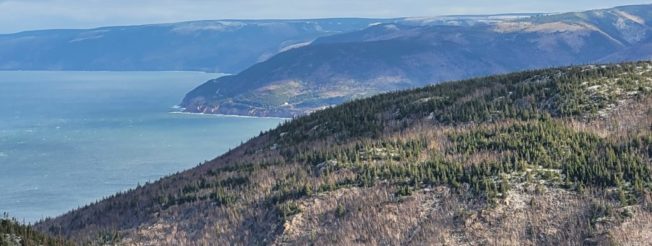
Buyer’s Guide: How to Buy Land in Nova Scotia
Who is this guide for?
I have driven all over Nova Scotia in search of prize parcels of land, gems tucked away in forests or remote coastlines that few have visited. I’ve seen places I’ll never forget. In writing this guide however, I’m quite aware that not everyone can devote such time and energy to their search for land. So here’s the first bit of good news – 90% of the work can be done from any laptop anywhere in the world. With the range of data and satellite mapping available today, you can get an in-depth view of any land parcel from Barrington to the top of Cape Breton. This document will hopefully be useful to everyone with an inclination to buy acres, but hopefully particularly valuable for those at a distance such as out-of-province buyers.
Why buy land?
Let’s start with the fundamental question of “why?” There are SO MANY reasons that buying land in Nova Scotia is a smart move. I’ll describe some here:
- Appreciation potential: unlike your car, your TV or your laptop that decrease in value for each year you own them, land is an asset that generally appreciates in value over time. And the best part is this appreciation happens passively through market forces – you can literally do nothing and watch your real estate values increase.
- Land is a fixed commodity: Money gets printed, new corporate stocks get issued, new cryptocurrencies and NFTs pop up daily – there are no expansion limits to these assets. Land, on the other hand, has a finite supply, No government or billionaire is issuing new land. It has a lasting value that is more durable and predictable than other asset classes.
- Low carrying costs: Owning a home, whether you live in it or not, involves significant upkeep and maintenance costs, plus taxes and insurance. Land, should you choose to leave it, will hold its value at very little cost to you. Most land owners pay only property taxes to maintain their land. We’ll dive into property taxes and assessments later – but suffice to say, the costs are minimal.
- Land has many uses: I tend to look for land that has potential for a great residential home or cabin. Others are looking for farmland or pasture. Forestry is a big industry in Nova Scotia as well. You can lease land for hunting or camping. And then there are many commercial / small business uses as well.
- Environment, sustainability and climate change: Natural land, particularly forested areas, have a beneficial effect on limiting climate change. Forests sequester twice as much carbon as they produce (wri.org). If you’re looking to improve your carbon footprint and achieve net-zero, sustainably managed forest lands can help you achieve that goal. You can also play a role in protecting natural habitats and flora and fauna.
- Land use opportunities are evolving: Voluntary carbon credit markets are expanding rapidly and the projected value of carbon credits is poised for rapid growth. Initiatives like the Family Forest Carbon Program are generating new revenue for woodlot owners who simply maintain a healthy forest. This activity generates carbon credits that have commercial value. We have yet to see these programs fully expand to Canada, but expect it will be soon.
- Leaving behind a legacy: What better inheritance for your successors than a beautiful place on Earth? Land is often passed down through multiple generations, making it a generous gift that has new potential with the next generation.
Why buy in Nova Scotia?
Appreciation potential: According to Statistics Canada, the average price per acre of “farmland with buildings” in Nova Scotia has increased over 40% in the last 10 years. But this is just an average – hot markets and unique properties (e.g. waterfront) have the potential for very strong return on investment.
Natural beauty: There’s only so much oceanfront in the world, and Nova Scotia certainly has its fair share. Add to that all the lakes and forests and rivers, and the diverse landscapes from the Annapolis Valley to the Cape Breton Highlands, and you’ve got something unique.
Affordability: Nova Scotia is among the most affordable places to buy land in Canada, according to Statistics Canada, ranking behind only Manitoba and virtually equivalent to Saskatchewan. By comparison, land in Ontario is nearly 5x more expensive. Check out our post on Nova Scotia vacant land sales statistics.
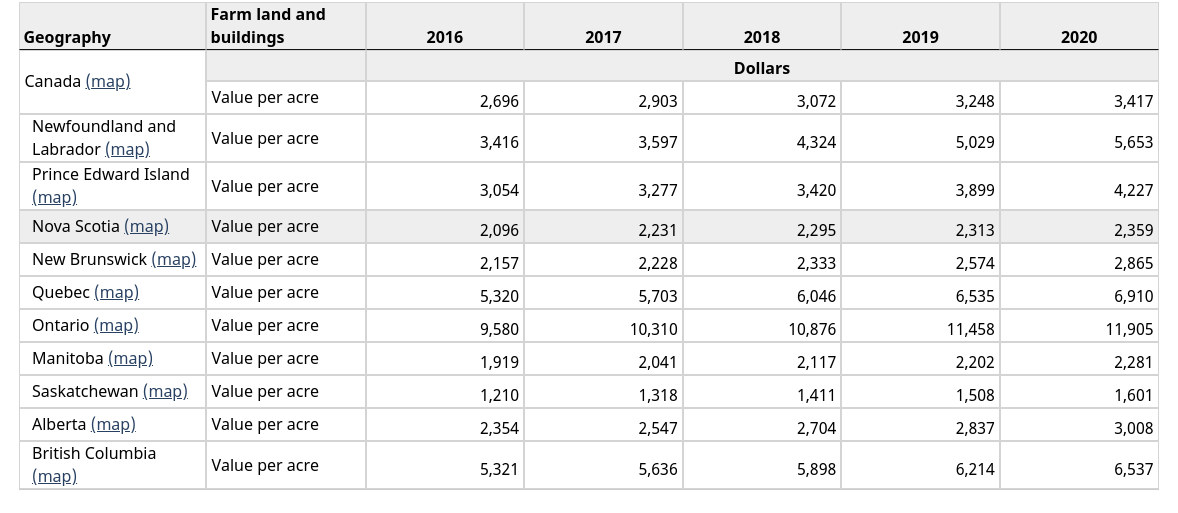
Where should I buy?
It’s a critical question. Nova Scotia has so much range in terms of geography, climate, access to infrastructure, land cost, and employment opportunities. So naturally the choice will vary based on your needs. You should start by narrowing it down to a cluster of counties.
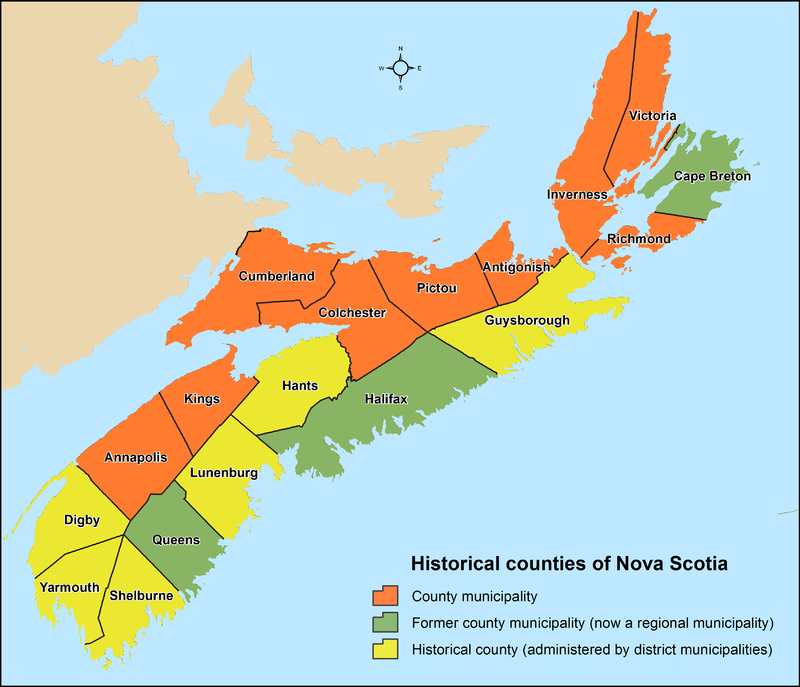
You can use some data here to help with your search. Are you looking for urban areas, or remote getaways? Population data provides a clue to that, particularly the last column below “population density”.
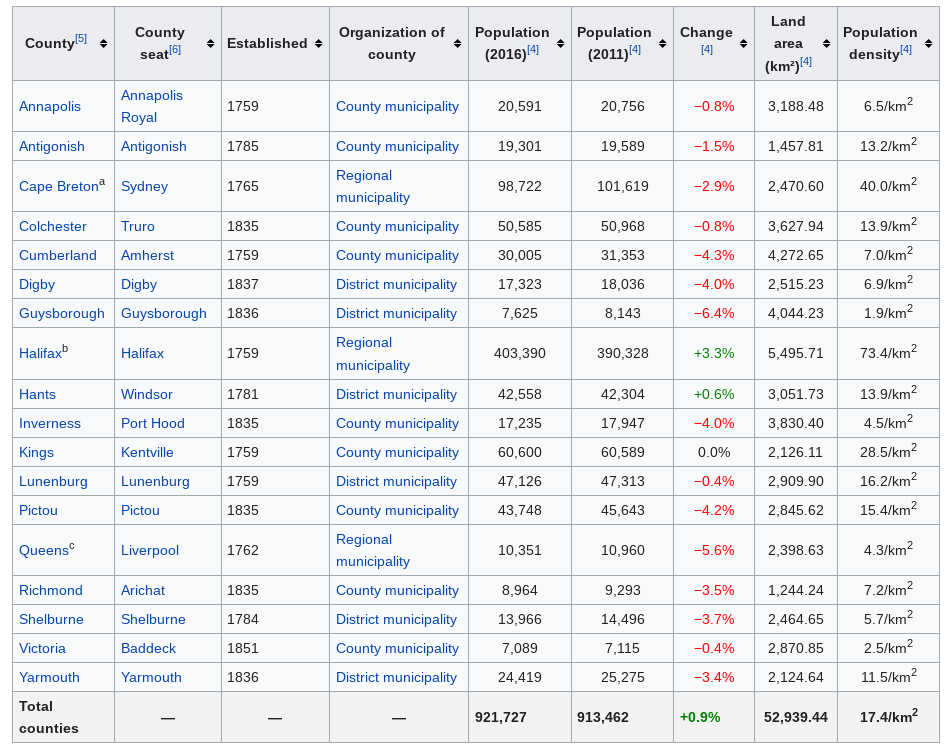
As for climate, there are certainly differences between counties, but I find these are overstated relative to the facts. The South Shore municipalities (Shelburne, Yarmouth, etc.) have milder winters due to Gulf Stream currents, whereas the more northern areas like Inverness is slightly colder due to the colder waters of the Gulf of St. Lawrence.
I have spent time in most, but not all, Nova Scotia counties. It’s so hard to generalize all those experiences, but here’s a few observations:
- Halifax is of course the epicentre, and generally land values are highest there and radiate outward
- South shore municipalities have milder winters, more fog, and are generally more remote
- Annapolis Valley is the spot of choice for farm produce
- Inverness and Cape Breton have higher elevation levels, providing the best mountain views
How to buy land in Nova Scotia
The most common method is through a realtor, which follows many of the same steps as purchasing a house. I’ll deal more with private sales here, which is what a lot of people ask about.
Buying through a Nova Scotia realtor: Local is always best. Find a realtor who lives and works in the vicinity that you’re searching. Talk to a few, and ask questions about their expertise in land, their commissions, and how they will help with your search. Once you’ve found a good fit, they’ll issue a contract. Read it carefully – you’re making a commitment to be their exclusive client for (how many months?) for any land purchases in (how big of an area?). These are boundaries and obligations you need to be aware of. If you’re out of province, a good realtor will do most of the looking for you and filter it down to the best opportunities. If you’re bold and trusting, you can buy the land sight-unseen – my recommendation will always be to visit and walk the property.
Buying through private sale: There is a huge hidden market in Nova Scotia of landholders who aren’t marketing their properties through MLS. I’ll dig in to how to find these opportunities later. A private sale is simply the purchase of a good between one party and another. It’s quite simple, but of course there are some important factors to watch for. Done right, it’s quick, painless, and commission-free!
Other methods of buying land: There are tax sales and foreclosure sales happening all the time. While I have fairly deep experience with these methods, they are not for your average buyer and I won’t go into detail here. There are also some great methods for buying land that is not for sale that I’ll cover in a future post.
Finding land to buy
Here we’ll cover the traditional method of finding land to purchase, as well as some lesser-known methods.
Real estate sites/apps: The global real estate sites such as realtor.ca, point2homes, zillow etc. will likely have some listings, but I prefer to use a regionally focused site. I’ll zoom in on the two that I use. Note that I’m almost always looking using a map as my main frame of reference, so for me a good map that plots land for sale is key.
- Viewpoint.ca: Viewpoint is focused exclusively on Nova Scotia. It’s a website with MLS listings as you’ll find elsewhere, but for me it stands out for the quality of its user interface, the integration of valuable data points, and some handy tools.
- RemaxNova: ReMax’s Nova Scotia focused web property is far better than those I’ve seen for other provinces, primarily for its quality map view and associated tools.
I will dive into some power user tips for these two properties a bit later in this document.
Classified Listings: You’ll find land for sale in local publications and their online properties. I find these a bit cumbersome and low-value based on my limited experience. Kijiji.ca is a faster alternative and has categories devoted to land for sale.
Facebook Groups: There is at least one Facebook group devoted to land for sale in Nova Scotia. Want to join it – search for “land for sale in Nova Scotia”
If you’ve narrowed your search to some key specifics (e.g. Lunenburg County, 6-10 acres with lake or river access), try posting a “wanted” post in Kijiji or a Facebook Group. It’s an easy way to reach out to private sellers who may have exactly what you need, without the competition of all the potential buyers browsing available MLS listings.
What’s in a Land Listing?
There’s a lot of detail in a typical listing of land for sale, so let’s take a look at the meaning and importance of these data points. Here’s a typical listing of land for sale from Viewpoint.ca:
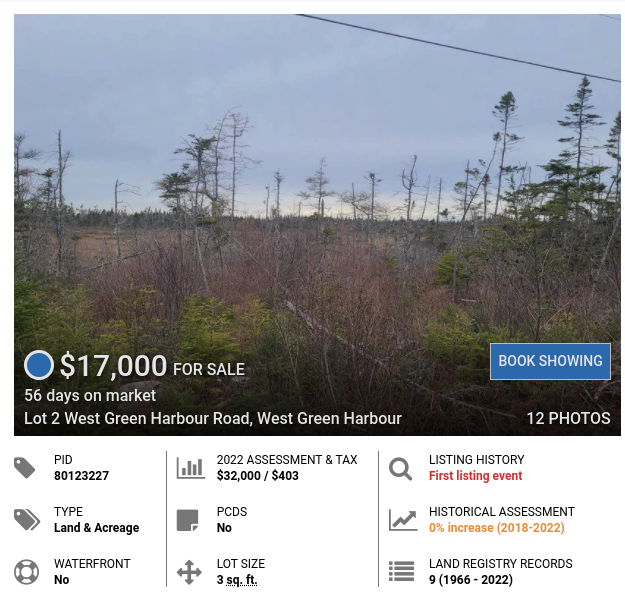
There’s some vital information here, some of which is obvious (e.g. price), and others that may require some explanation:
PID: The Property ID is the most valuable identifier of a land parcel. It’s a unique number that allows you to find that land and the boundaries of it through the various tools I describe in this guide. Sellers will usually include the PID when they reference a plot they have for sale, but if they don’t it should be the first piece of information you ask for. It’s essential – that’s why it’s top of the list for our good questions to ask when buying land.
Assessment value & Tax: These figures show the assessed value of the land, as well as the annual tax that is levied on the owner, which is based on Nova Scotia municipal tax rates. All of Nova Scotia’s property assessments are provided annually by Property Valuation Services Corporation (PVSC). As they explain on their site, assessment value is intended to reflect market value (what it would sell for), but never assume the two are the same. Actual market values can vary widely from assessment values, usually higher in a market with active buying and selling. It is however a useful reference point for looking at the relative value of the land compared to the selling price, and provides a clear indication of what the taxes will be (with some variance year to year).
Like the PID, each parcel of land is attached a unique number that relates to the assessed value. This is the AAN or AANN. In Viewpoint, hovering over this listing on the map reveals the AAN number. It’s important to know this number as well. You can use it to do a lookup on pvsc.ca and find valuable additional information on the property.
PCDS: This stands for Property Condition Disclosure Statement or PDS for Property Disclosure Statement. Here is more info from the Nova Scotia Real Estate Commission. Now here’s my take on it. Buying land vs. buying a home or commercial real estate involves different risks and different forms of due diligence. Some examples:
- A home may have a leaky oil tank that creates soil contamination. A good home inspector and possibly an environmental assessment may be required.
- A home may have an under-the-radar extension to it that is not up to code and has no associated permit with the municipality. Again, a good home inspection can help.
Land, on the other hand, has different types of risks.
- Coastal properties may suffer from increased flooding or erosion risk due to rising water levels
- Land that appears nice and dry in good weather may be flooded and soggy 9 months of the year
Most land that I see, have purchased or sold, is as nature built it, with few signs of human influence. With these types of properties, I’m mainly looking for nature-based risks that would diminish the land’s value. If there’s a run-down sawmill on the property, whole different ball game – more due diligence required.
Bottom line is a PCDS or PDS is a good idea if you’re purchasing a building. Land that is unused has less risk, and I would not suggest limiting your search to those that offer PCDS documents as those are exceedingly rare based on my experience.
Lot Size: Fairly obvious, but occasionally you’ll be required to compare square feet against acres against hectares. Square feet is common to most people. There are 43,560 square feet in one acre. Got it? Here’s an easier reference… remember your old high school football field? Include the end zones and now you’re picturing what one acre looks like. So eight acres is 8 football fields. A hectare is 2.47 acres – let’s just stick with acres!
The smallest lot I have purchased in Nova Scotia was 21,000 square feet, so almost a half acre. The largest was 204 acres. The median size lot for a typical city dweller is 7,700 square feet – but unless you’re looking at something in metropolitan Halifax, you’ll likely want something larger to give yourself room to roam!
A good property search tool like Viewpoint or ReMaxNova will also allow you to see sales history for the lot, as well as tax assessment history and other details.
So what can you not tell from a listing? Some pretty vital details:
- Accessibility: Is it accessible by a 4-season, well-maintained road? Is it landlocked?
- Proximity to…: where’s the nearest gas station, store, town, hospital, school? How far to the nearest lake or ocean?
- Views: Can you see the ocean? Does it have elevation that allows you to watch the sunset? These can be factors that affect price dramatically.
- Terrain: what is the land made up of? Forest, meadow, marsh?
- Timber value: has it been clear-cut recently? Is there commercial value in the standing timber?
- Zoning uses: Can you build on it? We’ve compiled a complete list of Nova Scotia land use bylaws and zoning maps for each county and municipality.
- Access to power: are there hydro lines in the vicinity?
- Sewage and water: The most common method in rural lands is a well and a septic tank, but some areas have access to municipal sewer and water lines
Power User tips for reviewing online land listings
Here are the most useful tips I’ve found for reviewing land listings. Hopefully they save you as much time as they’ve save me!
- Filters, filters, filters: Often the most meaningful method you’ll find for evaluating the market value of land comes from comparable sales of similar land lots in the vicinity. I look for land lots of similar size and quality as close as possible. Two filters are useful here:
- ReMaxNova has a filter for “Class”, and you can select “vacant land” to see only listings of this type. This is handy, but I don’t use it exclusively – seeing nearby home sale values is also a good indicator of land value.
- A good map like Viewpoint or ReMaxNova will allow you to toggle on/off listings that are “active”, “pending” or “sold”. Very useful for comparing against land you’re looking at. Active listings are useful, but bear in mind some sell for less than asking price. Pending sales are a better indicator of actual value, and sold listings are genuine money in the bank.
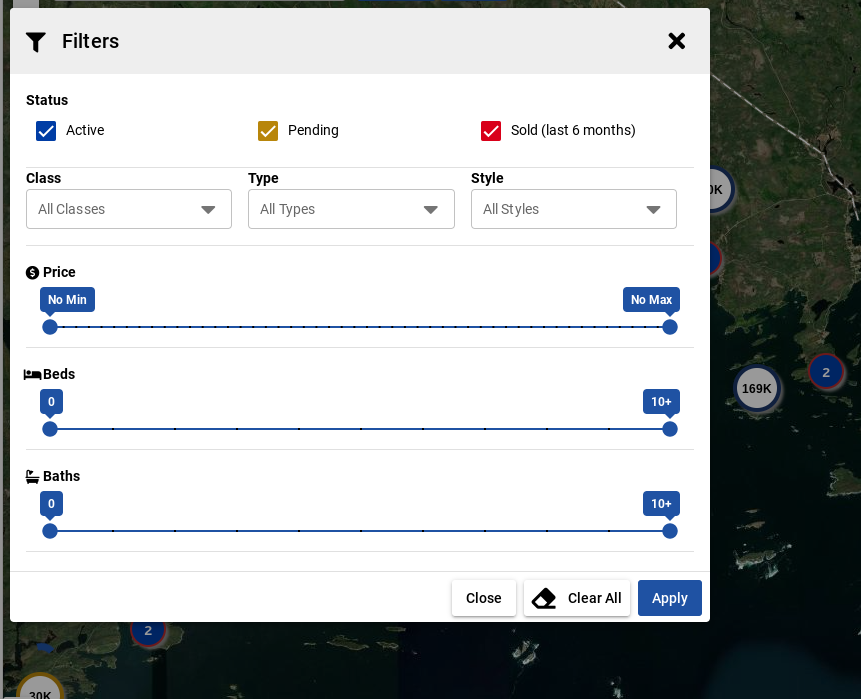
Use filters to compare against similar properties sold in the vicinity.
- View terrain through multiple lenses: ReMaxNova uses a different satellite imagery system than Google Earth. Why is this important? A view that shows a lush forest in one might be clear-cut in the other. A dry area in one might be flooded in the other. Scanning multiple views gives you more pictures from above and a more accurate picture. You can also see a topographic view of the land, showing elevation, marshy areas and other natural highlights – very useful for spotting swampland!
- Note the date of the satellite imagery: Sources like Viewpoint that pull in Google Maps imagery will always list the copyright as “Google (current year)”. Viewing that same image in Google Maps will show you the actual year it was taken, sometimes more than a decade ago! I’ll deliberately go to Google Maps to determine how old the satellite photos are.
- Always look at Street View, when available: Viewpoint nicely integrates Google’s Street View so you can zoom in on listings and get a much closer look. This really gives you a feel for the terrain as well as the quality of the property and other important factors like road conditions, views from the property, etc. There are many rural areas that are not mapped with Street View however. In these cases, you sometimes you can get a view from a nearby road – not as useful but still gives you an impression of the landscape, tree height, forest quality, etc.
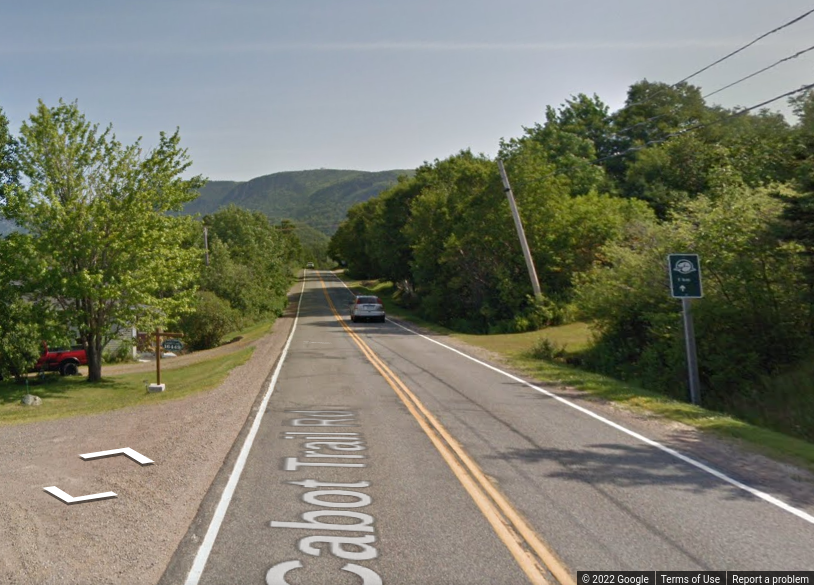
Street View is a great way to get a closer look at an area, noting property views, access to power lines, and terrain quality. Viewpoint integrates this view, but go to Google Maps directly to note the actual year of the satellite imagery (in this case 2018)
A handy measuring tool: Viewpoint has a great “measuring tool” feature that allows you to pick points on a map and easily measure the distance in between. Extremely useful. Update: RemaxNova has a handy measuring tool as well! And it works well on the mobile view of their site too.
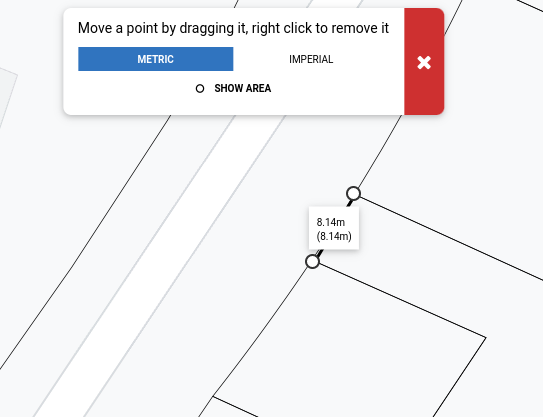
Is there room for a driveway? Viewpoint’s measuring tool helps you find out.
Things you can’t see on a map
There are of course many important details that a map view won’t illuminate. The two main ones are zoning details and title issues.
Zoning Bylaws
Zoning refers to land use bylaws of the local municipality. These are highly localized to the specific area – no one-size-fits-all answers. If there’s a realtor involved on the buying or selling side, they should be able to inform you of the zoning and the relevant uses. For a private sale, searching within the municipality may yield some luck. UPDATE! Search no further my friend… we’ve compiled links to all Nova Scotia land zoning maps and land use bylaws for every region in Nova Scotia.
Let’s use an example. I have a 14-acre lot near the Cabot Trail that falls under the jurisdiction of the County of Inverness. Through our handy list of all Nova Scotia zoning maps I was able to find the zoning map for Inverness and determine that my lot is zoned as RR-1 – Rural-Residential. From there it’s a matter of digging into the relevant local land use bylaw. These are long documents that contain all the ordinances associated with each type of zone. For RR1, for example, the following land uses are permitted:
- Single detached dwelling
- Duplex and Semi-detached dwellings
- Converted dwelling up to two units
- Mobile homes subject to setback requirements
- Cottages and other seasonal dwellings
- Tourist and guest homes
- Agricultural uses including barns and stables
- Forestry uses
- Post offices
- Community centres
- School, churches, cemeteries and other similar institutional uses
- Recreational uses such as parks and playgrounds, golf courses, beaches and associated buildings and uses
- Campgrounds and associated uses
- Existing Mobile Homes which are located within the 300 foot setback requirement from the Cabot Trail
The document also contains provisions for minimum yard space and maximum height of buildings. Now, this is an example of when you fairly easily find what you’re looking for. In many cases you won’t – you can always get in touch with the municipality if you need a definitive answer. Adhering to Nova Scotia’s zoning bylaws is quite important and it’s a good idea to review these provisions in detail, even if you have a realtor summarizing the information for you. If you have a specific plan in mind for the lot (e.g. building a summer campground) talking directly with the person who approves permits could provide you with some vital information for your go/no-go decision.
Title Issues
Title refers to the legal documents binding the land to a specific owner, as well as details and provisions specific to that land. It includes, among other things:
- The various deeds associated with the property over the years
- A map of the property
- Easements and rights of way (often included in the deeds mentioned above). These are especially important when land appears landlocked (no road in) or if there are shared private laneways or driveways. You’ll also find that many easements exist for logging operations within Nova Scotia.
- Claimholders on the property (e.g. mortgage owner)
Title reviews and issues are often the realm of Nova Scotia real estate lawyers, and I’m not one. Typically a title review is a step undertaken by a lawyer late in the purchase process. It ensures the land is indeed owned as indicated and identifies any potential red flags for the buyer.
You can, however, gain access to the database that houses all documents related to properties in Nova Scotia. Access Nova Scotia’s Property Online (POL) database is available to subscribers for roughly $100 monthly (as of March 2023). I pay this fee and use this land registry database as an essential component of due diligence as I research properties. For buyers who are considering a private sale of Nova Scotia land, as an early step in their process, I recommend conducting a title search using Property Online’s Land Registry.
Closing the purchase of your land
Much like buying a house, the purchase of land involves the following steps. Usually there’s a series of questions from seller to buyer (directly in a private sale, or through a realtor when one is involved). There are a lot of important things to look into and ask about, which is why we compiled our list of Good (and bad) questions to ask when buying land in Nova Scotia.
Once the potential buyer has all the information they need, the next steps are:
- Negotiation, or the presentation of a written offer
- Signed acceptance of the offer and associated terms
- Deposit delivered by buyer within a specified timeframe
- Title search and deed transferal / registration conducted by the buyer’s real estate lawyer
I’m not going to dive into a lot of detail on these steps as they are pretty straightforward and likely better explained by a realtor or a lawyer. I will comment however on some differences associated with a private sale of land.
Private Sales and Seller Financing
Private sales are typically less formal and more flexible. There is a period of questions and answers between the buyer and seller, warming up to negotiations and an offer. There is room for unorthodox financing methods: I’ve had a potential buyer offer me to trade his truck for land, for example. Seller financing is a flexible option in private sales. When the buyer is willing, they can work with the seller to establish terms of payment on a set schedule. Typically the deed is not transferred until payments are complete. An important discussion point in these agreements is how the land can be used while payments are being made. Can the buyer begin to develop the property? Can trees be cut down? Sellers will be cautious due to liability concerns, so ensure that these points are talked through and jointly understood.
When all factors align, a Nova Scotia real estate lawyer is engaged to draft a sale agreement. This specifies the sale price, deposit amount, terms of payment, and when/how the deed is transferred. As a buyer, you should engage a lawyer to review this document in detail. Most agreements are fairly standard, but you don’t want to regret something later. Below is a fairly basic and standard template of the steps involved in a sale with seller financing. We’ve also added a sample Purchase & Sale Agreement for vacant land in Nova Scotia, with seller financing terms included. It’s important that your agreement includes any loan conditions such as downpayment, interest rates, and payment intervals. You can use an online loan calculator to determine these amounts.
| Action | Owner |
Description |
|
|
1. |
Review confirmation of ownership | Buyer |
Attached document provided as proof of title ownership |
| 2. | Send initial deposit (e-transfer) | Buyer |
$XXX deposit, refundable if sale agreement is not signed. Once received, owner will pause all advertising and negotiations with other buyers. Receipt provided by Owner. |
| 3. | Lawyer engaged to migrate land and create sale agreement | Owner |
(Name of) law firm engaged to migrate property and draft sales agreement. Legal fees paid by Owner. |
| 4. | Review and signing of Sale Agreement | Buyer |
Sale agreement specifies downpayment, monthly payment terms, conditions of sale. |
| 5. | Downpayment sent to Owner | Buyer |
$XX,XXX delivered to Owner |
| 6. | Access to land | Buyer |
Buyer is granted access to land upon delivery of downpayment, subject to usage terms of sale agreement. |
| 7. | Monthly payments | Buyer |
Monthly e-transfers to owner based on sale agreement schedule. Written confirmation of payments provided by owner. |
| 8. | Deed Transfer | Owner |
Upon completion of final payment, Owner will transfer title of deed to Buyer. |
Do I need insurance on vacant land?
I’ve been asked by land buyers whether they should hold an insurance policy on their land. The short-but-not-terribly-helpful answer is: it depends. I won’t give a prescriptive answer, just my opinion – and of course you might want to consult with your lawyer. I have multiple lots of vacant land, in remote areas. I don’t lease it out for hunting, I don’t grant permission for access to hikers or snowmobilers, I’m not aware of any open wells or … pit mines… someone might fall into, and I’m not located in shared paths that others might tread. So, no insurance for me at this time. Should someone trespass on my land and injure themselves, I’m fairly confident that I won’t be held liable, so I take that risk. There’s no excuse for negligence however, regardless of the insurance you carry – if there are hazards on your land, take appropriate action to ensure no one gets hurt.
On the other hand, if you have a shared right of way on your property, or agree for any reason to allow others to access your land, it’s worth looking into. Also, if your property has value in the form of standing timber, fire insurance is something to consider.
Is there HST or other tax on land sales?
Most sales of vacant land by individuals are exempt from HST, in Nova Scotia and across Canada. According to the CRA information sheet, examples of exempt sales are:
- the sale of land that had been kept for personal use; or
- the sale to a relative (or to a former spouse or common-law partner) for their personal use of a parcel of land created by subdividing another parcel.
However, there are situations when sales of land by individuals may be taxable. Examples of taxable sales include:
- the sale of land that is capital property that had been used primarily in a business;
- the sale of land in the course of a business; or
- the sale of a parcel of land created by subdividing another parcel into more than two parts.
Based on these definitions, the sale of farm land in Nova Scotia is generally taxable at the HST rate of 15%, but there are some allowable exceptions.
As a buyer, you don’t need to know the specifics of the tax code re: HST applicability. That’s up the to the seller to determine. Just make sure you know whether HST is included, additional to, or not applicable on the sale of the property in question.
If you are out of province, you should definitely be aware of Nova Scotia’s non-resident deed transfer tax, which is 5%. For more on this, view our blog post on the non-resident deed transfer tax. Lastly, for a full round-up of the taxes that may be applicable on a sale/purchase of land, visit our post on Taxes on Land Sales in Nova Scotia.
Conclusion
Owning a portion of Nova Scotia’s natural beauty is something unique and special. I hope you found my tips, advice and information useful, and I hope your search is fruitful in terms of landing you the place of your dreams. Another piece of advice – don’t get lost! Learn about using Nova Scotia GIS maps and you can never be lost again. Then, finally, once you’ve got that land purchased, you’ll be ready to dive into our Nova Scotia Land Development Guide.
I’ll continue to update this document over time, and your feedback can likely make it much better. Please feel free to add a comment below – I will read them all and give them careful consideration.
